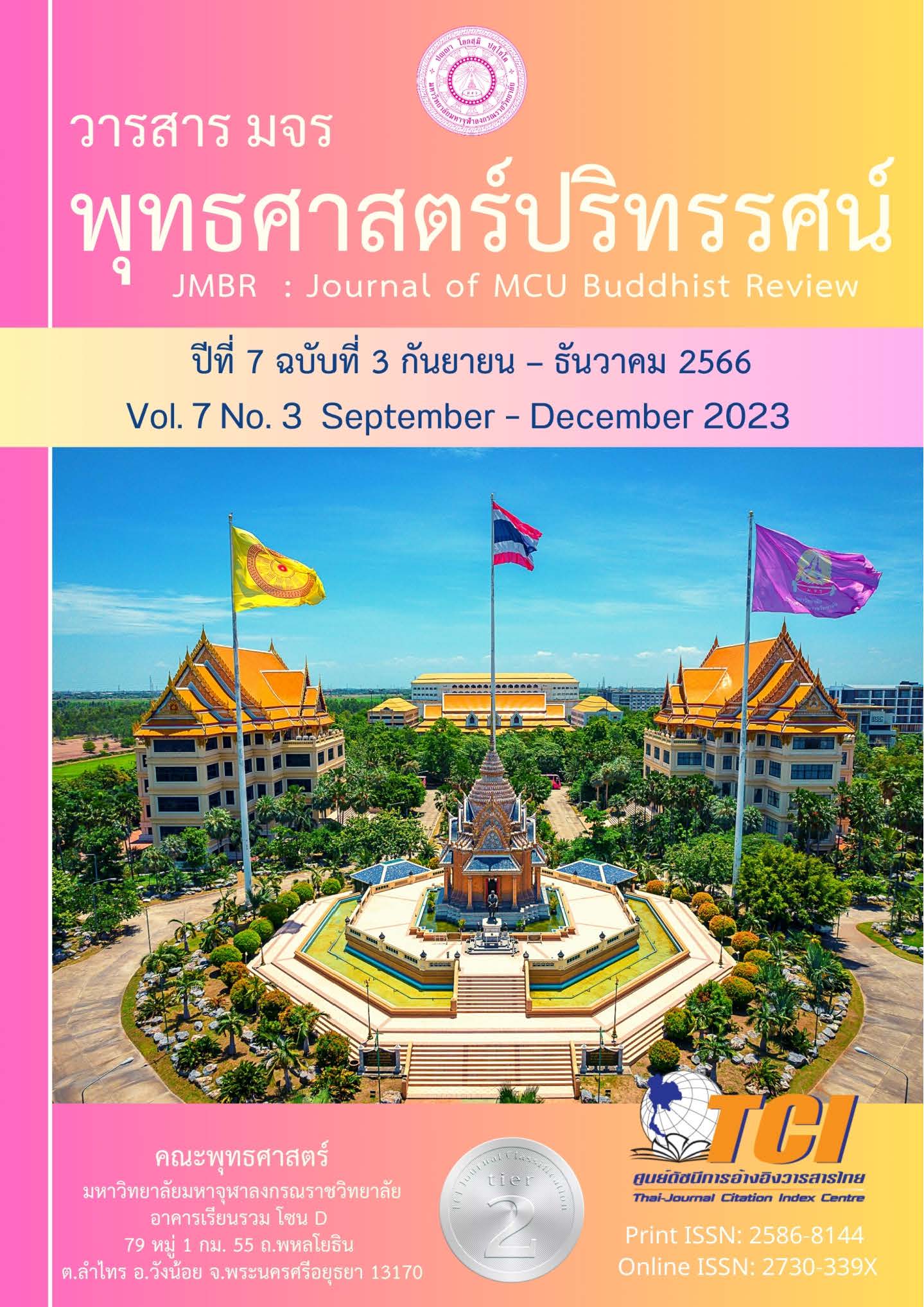การออกแบบผังแหล่งโบราณคดีทางพระพุทธศาสนาสมัยทวารวดี ในจังหวัดนครสวรรค์-อุทัยธานี
Main Article Content
บทคัดย่อ
บทความวิจัยนี้มีวัตถุประสงค์ 1) เพื่อเพื่อศึกษาแนวคิดการออกแบบผังสิ่งแวดล้อมและแหล่งโบราณคดี 2) เพื่อพัฒนาการออกแบบผังแหล่งโบราณคดีทางพระพุทธศาสนาสมัยทวารวดีในจังหวัดนครสวรรค์-อุทัยธานี 3) เพื่อศึกษาประโยชน์การใช้ผังแหล่งโบราณคดีทางพระพุทธศาสนาสมัยทวารวดีในจังหวัดนครสวรรค์-อุทัยธานี เป็นการวิจัยเชิงคุณภาพ มีการสัมภาษณ์ การสังเกต และการปฏิบัติการรวมกันในพื้นที่จังหวัดนครสวรรค์-อุทัยธานี ผู้ให้ข้อมูล 45 คน ใช้กระบวนการตามวงจรเดมมิง วิเคราะห์ข้อมูลและนำเสนอผลวิจัยเชิงพรรณนา
ผลการวิจัยพบว่า 1) การออกแบบผังสิ่งแวดล้อมและแหล่งโบราณคดีนั้นถือว่าเป็นเรื่องที่มีความสำคัญเนื่องจากว่าการออกแบบผังแหล่งโบราณคดี จะเป็นสิ่งที่สามารถเข้าไปช่วยนำทางในการเข้าถึงพื้นที่ของแหล่งโบราณคดีนั้นได้ง่าย โดยหลักของการออกแบบผังแหล่งโบราณคดีนั้นจะต้องมุ่งถึงความเรียบง่ายชัดเจนและระบุที่ตั้งของอาคารและศาสนาสถานอื่นๆ ภายในได้อย่างชัดเจนโดยการใช้สัญลักษณ์แทนการระบุสิ่งของอาคารหรือพื้นที่เหล่านั้น 2) การออกแบบผังแหล่งโบราณคดีทางพระพุทธศาสนาสมัยทวารวดีในจังหวัดนครสวรรค์-อุทัยธานีได้ดำเนินการออกแบบผังแหล่งโบราณคดีจำนวน 5 เมือง ได้แก่ (1) ในจังหวัดนครสวรรค์จำนวน 3 เมือง (2) ในจังหวัดอุทัยธานีจำนวน 2 เมือง โดยงมีการออกแบบใน 3 ส่วน คือ (1) ออกแบบผังภูมิสถาปัตย์ (2) ออกแบบผังเชิงพื้นที่ (3) ออกแบบผังเส้นทางการเข้าถึงแหล่งโบราณคดี 3) ผลการดำเนินการออกแบบก่อให้เกิดประโยชน์ คือ (1) ประชาชนในพื้นที่เข้าใจในผังของแหล่งโบราณคดีได้ดีและสามารถเข้าถึงแหล่งโบราณคดีได้ง่าย (2) มีความรู้ความเข้าใจในประวัติศาสตร์ของสถานที่นั้น (3) ก่อให้เกิดประโยชน์ในการท่องเที่ยวผ่านผังดังกล่าวได้
Article Details

อนุญาตภายใต้เงื่อนไข Creative Commons Attribution-NonCommercial-NoDerivatives 4.0 International License.
- บทความที่ได้รับการตีพิมพ์เป็นลิขสิทธิ์ของวารสาร มจร พุทธศาสตร์ปริทรรศน์
- ข้อความใดๆ ที่ปรากฎในบทความที่ได้รับการตีพิมพ์ในวารสาร ถือเป็นความรับผิดชอบของผู้เขียนบทความ และข้อคิดเห็นนั้นไม่ถือว่าเป็นทัศนะและความรับผิดชอบของกองบรรณาธิการวารสาร มจร พุทธศาสตร์ปริทรรศน์
เอกสารอ้างอิง
กรมศิลปากร. (2531). โบราณคดีสี่ภาค. กรุงเทพฯ: โรงพิมพ์หัตถศิลป์.
จี. เซเดส์. (2521). ชนชาติต่าง ๆ ในแหลมอินโดจีน. แปลโดย ปัญญา บริสุทธิ์. กรุงเทพฯ: มูลนิธิโครงการตำราสังคมศาสตร์และมนุษย์ศาสตร์.
โชติ กัลนาณมิตร. (2521). ไตรภูมิในพระพุทธศาสนากับสถาปัตยกรรมย: คําสอนเชิงวิเคราะห์์แม่แบบสถาปัตยกรรมไทย. (เอกสารอัดสําเนา). ม.ป.ท.: ม.ป.พ
พระธรรมปิฎก (ป.อ.ปยุตโต). (2540). พระพุทธศาสนาในอาเซีย. กรุงเทพฯ: ธรรมสภา.
พระส่งเสริม แสงทอง. (2541). แนวคิดการจัดการสิ่งแวดล้อมตามหลักทางพุทธศาสนา. ปริญญาศิลปะศาสตรมหาบัณฑิต บัณฑิตวิทยาลัย: มหาวิทยาลัยเชียงใหม่.
มหาจุฬาลงกรณราชวิทยาลัย. (2539). พระไตรปิฎกภาษาไทย ฉบับมหาจุฬาลงกรณราชวิทยาลัย. กรุงเทพฯ: มหาจุฬาลงกรณราชวิทยาลัย.
มานพ นักการเรียน และบานชื่น นักการเรียน. (2564). ทวารวดี: มิติทางความเชื่อและศาสนา Dvaravati: Belief and Religious Dimension. วารสารสิรินธรปริทรรศน์. 22(1), 256.
วิศรุต เนาวสุวรรณ์. (2546). แนวทางการปรับปรุงภูมิทัศน์เมืองประวัติศาสตร์ลพบุรี. วิทยานิพนธ์สถาปัตยกรรมศาสตรมหาบัณฑิต บัณฑิตวิทยาลัย: จุฬาลงกรณ์มหาวิทยาลัย.
เสถียร โพธินันทะ. (2535). ประวัติศาสตร์พระพุทธศาสนา. กรุงเทพฯ: มหามกุฏราชวิทยาลัย.
สุทธิลักษณ์ นิลเอสงค์ (2561). บูรณาการพุทธนิเวศเพื่อแก้ปัญหาสิ่งแวดล้อม. ปริญญาพุทธศาสตรดุษฏีบัณฑิต บัณฑิตวิทยาลัย: มหาจุฬาลงกรณราชวิทยาลัย.
สมเกียรติ ชัยพิบูลย์. (2551). การจัดการท่องเที่ยวเชิงวัฒนธรรม: กรณีศึกษาศักยภาพการท่องเที่ยวชุมชนนครชุม อำเภอเมือง จังหวัดกำแพงเพชร. กำแพงเพชร: มหาวิทยาลัยราชภัฏกำแพงเพชร.
สุจิตต์ วงศ์เทศ. (2548). คนไทยมาจากไหน. กรุงเทพฯ: สำนักพิมพ์มติชน.


